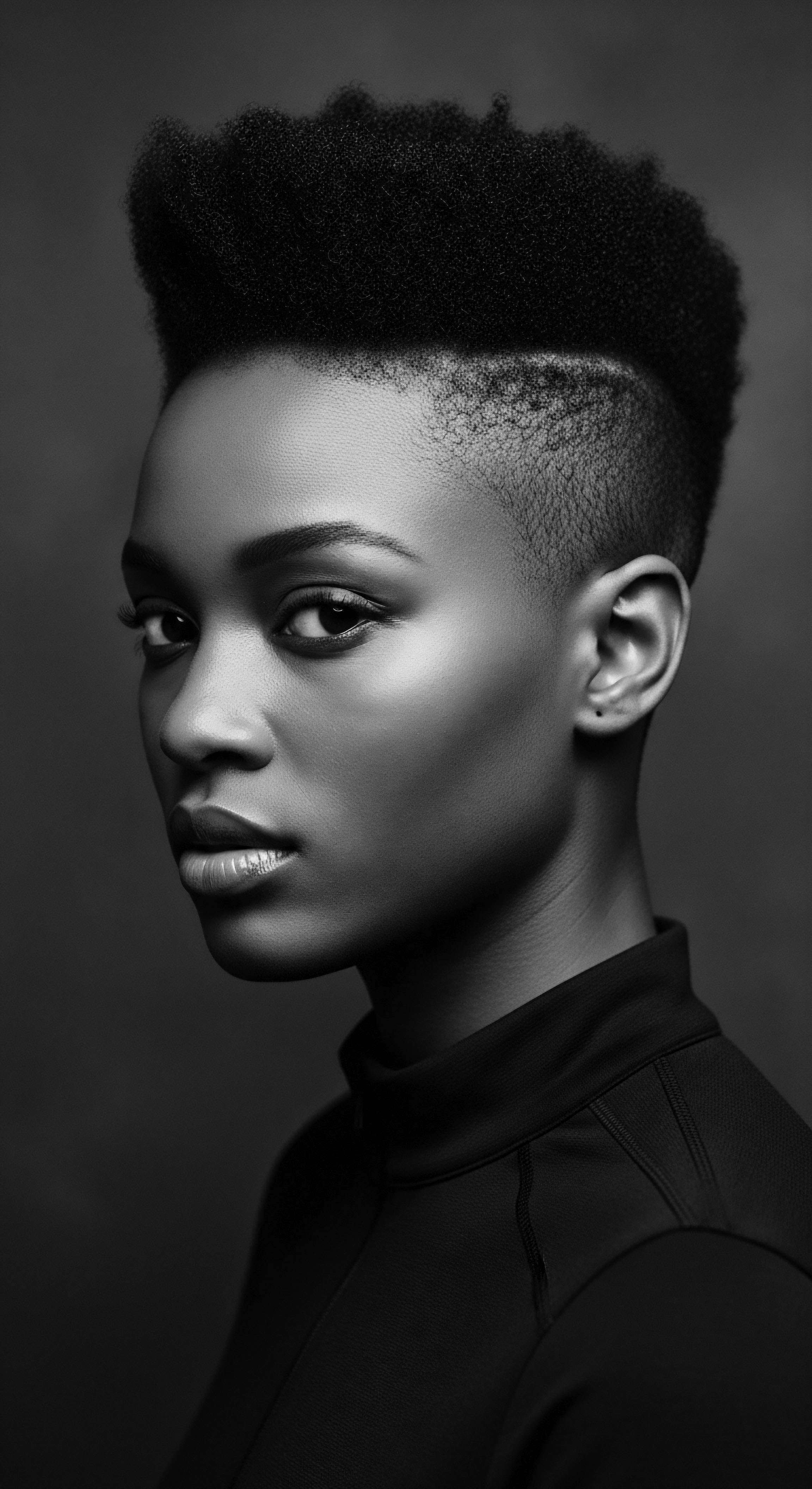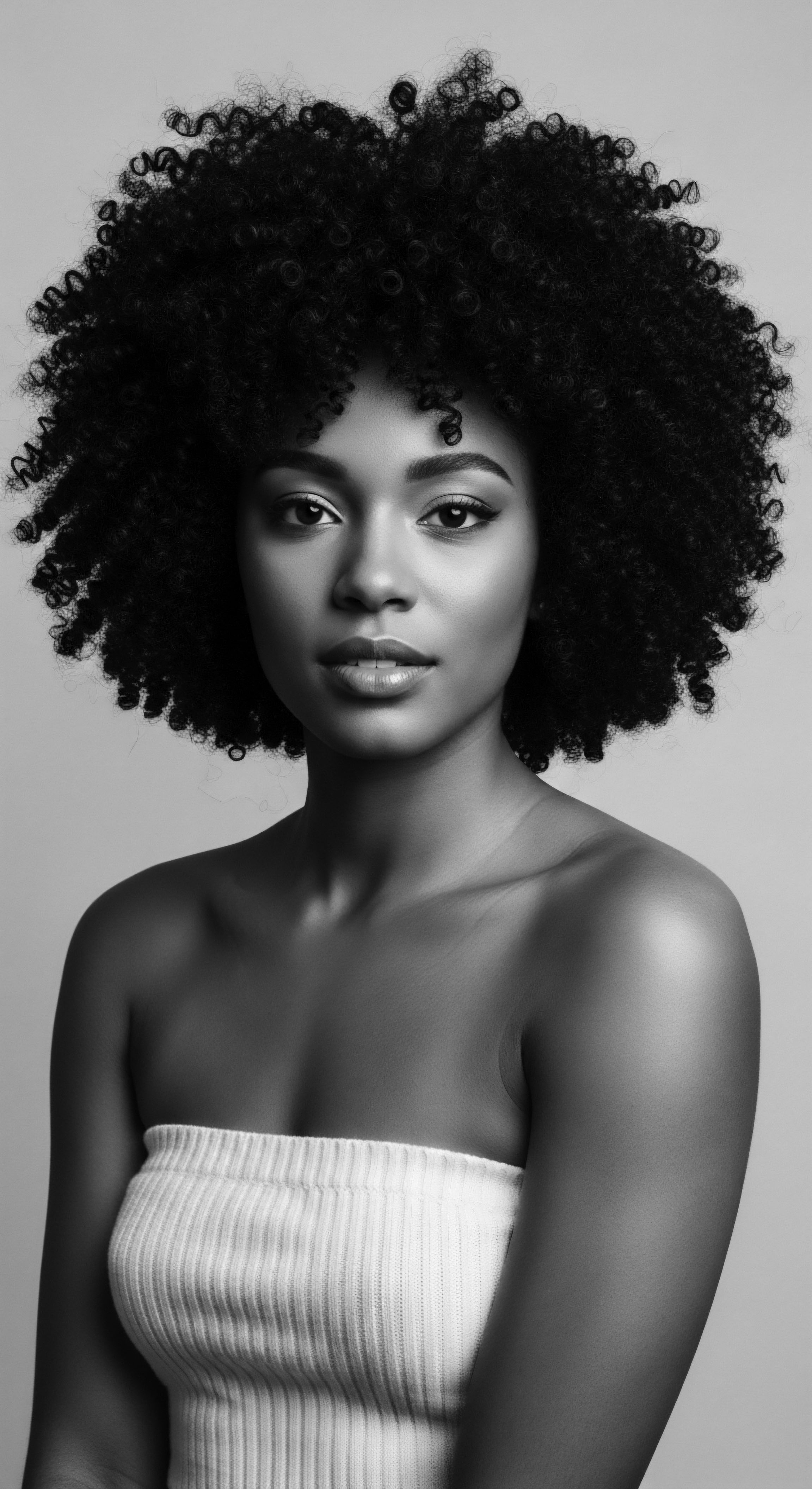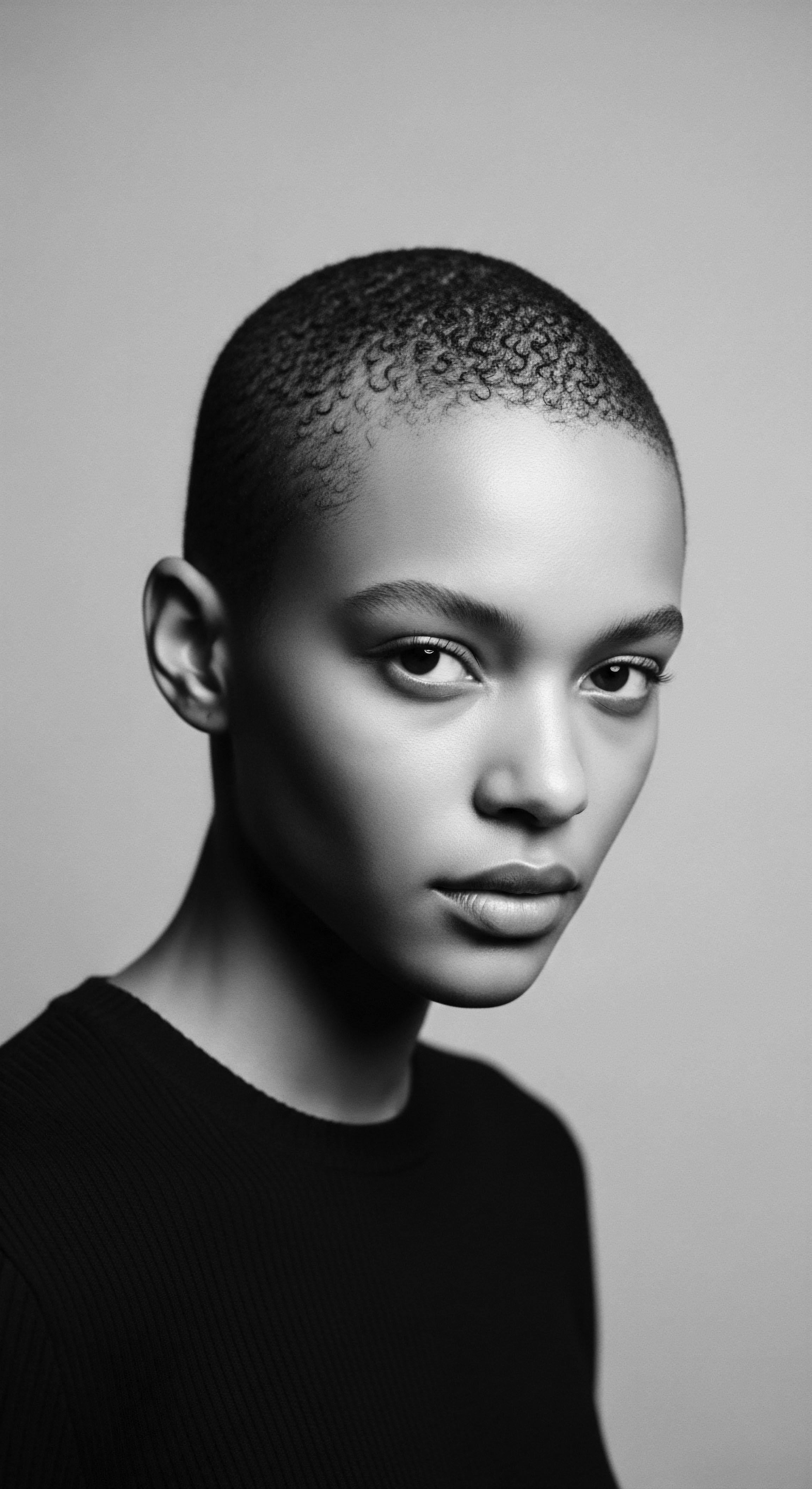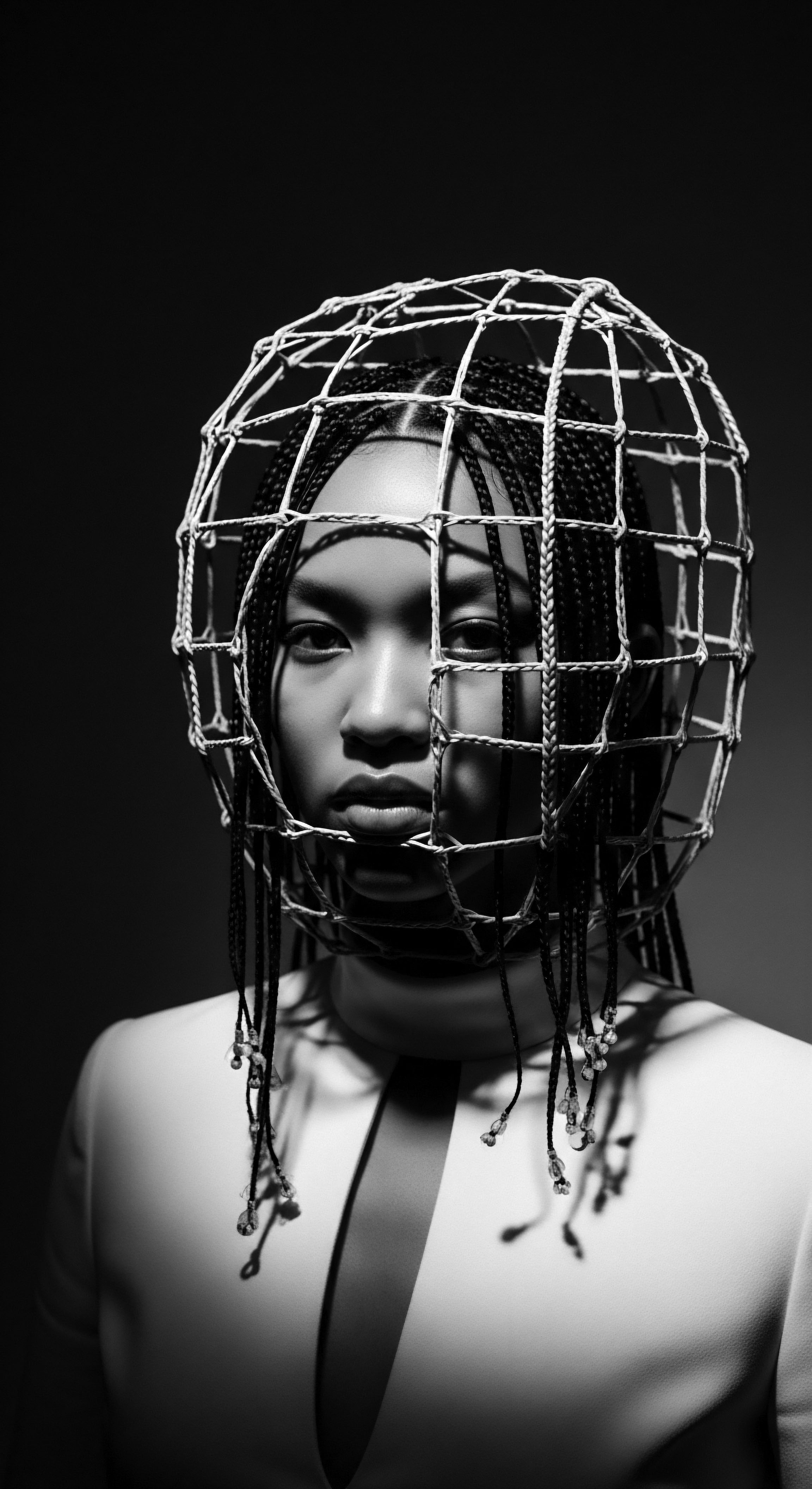The very mention of enslavement brings a hush to the air, a reverence for the resilience that pulsed through generations. To speak of textured hair in this context is to trace an ancestral whisper, a story etched not in parchment, but in the coiled spirals, the tight kinks, the undeniable strength of each strand. For those forcibly taken from their homelands, hair was not merely an adornment; it became a profound, living archive.
It held memories, codes, and a fierce, quiet defiance against the brutal machinery of dehumanization. Here, we delve into the ways textured hair, a sacred inheritance, served as a tool for survival.

Roots
In the vast, verdant landscapes of pre-colonial Africa, hair held a position of profound esteem. It was a crown, a canvas, a living testament to one’s lineage, social standing, age, marital status, and even spiritual connection. Communities would spend hours, sometimes days, collectively tending to hair, braiding intricate patterns that spoke volumes about identity and belonging. This was a communal art, a shared ritual, a deeply personal and public expression of self.
Hairdressers, possessing skills passed down through generations, were often revered as trusted members of society. This rich tapestry of meaning, however, faced an unthinkable assault with the onset of the transatlantic trade.

The Erasing of Identity
The journey across the Middle Passage was a deliberate act of stripping away. Millions of African people, snatched from their homes, faced systematic attempts to sever their ties to culture and self. One of the initial, brutal acts inflicted upon them was the forcible shaving of their heads.
This act, often explained away by captors as a means to control hygiene during the horrific voyages, carried a far deeper, more sinister purpose. It was an act of profound symbolic violence, a calculated effort to erase the very identity that hair had so vibrantly expressed.
Pre-enslavement, hair braiding, often intricate and time-consuming, served as a powerful social activity where bonds were strengthened as women, and sometimes men, socialized while styling each other’s hair. The deliberate removal of this vital connection to self, community, and the spiritual realm was intended to leave enslaved Africans an anonymous, malleable mass. Yet, even in the face of such devastation, the spirit of resistance, woven into the very structure of their hair, began to manifest.
Textured hair, once a vibrant marker of identity in Africa, became a profound symbol of defiance against dehumanization during enslavement.

Hair’s Unwritten Language
Despite the immense pressure to conform to Eurocentric beauty standards that deemed coiled hair unattractive, enslaved individuals found ways to express individuality through their hair. The inherent versatility and structural integrity of textured hair, characterized by its tight curls and coils, allowed for styles that were not only protective in the harsh conditions of plantation life but also served as a secret language.
- Cornrows ❉ These ancient braiding patterns, deeply rooted in African tradition, became a covert communication network.
- Headwraps ❉ Initially a spontaneous practice, headwraps evolved into a powerful statement. Though laws like Louisiana’s Tignon Law (1786) sought to enforce them as a marker of inferiority for Black and biracial women, these women transformed plain wraps into elaborate, adorned statements of coquetry and defiance.
- Protective Styles ❉ Styles like braids and twists helped manage hair under brutal conditions, protecting it from damage and retaining moisture without access to traditional tools or products.
The resilience of textured hair, biologically suited for the African climate with its ability to insulate the scalp and retain moisture, became a quiet, enduring ally in an environment designed to extinguish agency. It stood as a biological testament to origins, a physical link to a stolen past, and a living, breathing refusal to be completely erased.

Ritual
Under the unforgiving gaze of the plantation, the communal grooming rituals of Africa, once vibrant social gatherings, transformed into clandestine acts of survival. Hair care, no longer a display of status or beauty, became a practical necessity and a profound, quiet act of cultural preservation. The resilience of these practices, often relegated to brief moments of respite, underscores the enduring spirit of ancestral wisdom.

Care in Scarcity
Enslaved people faced unimaginable scarcity. Access to proper hair care products and tools, common in their homelands, was almost nonexistent. Despite this, ingenuity flourished. They fashioned combs and picks from whatever materials were available, often from wood or bone.
To moisturize and protect their hair from the harsh sun and demanding labor, they turned to what they could find ❉ natural oils, animal fats like butter, bacon grease, or goose grease. These improvised regimens, though crude by modern standards, reflect a deep, intuitive understanding of their hair’s needs, echoing ancestral knowledge of botanicals and natural remedies.
The hidden maps braided into hair exemplified a genius of communication, transforming a personal expression into a communal lifeline.
The time dedicated to hair care, typically Sundays, the only day of rest, became a communal tradition. This was not just about physical grooming; it was about connection. Mothers and grandmothers would tend to the hair of children, imparting not only techniques but also oral histories, stories, and the unspoken tenets of their heritage. This intimate act fostered bonds, created shared experiences, and ensured the continuity of cultural practices, even in the most oppressive circumstances.
(Byrd & Tharps, 2014, p. 10)
| Ancestral Practice Communal Braiding for social cohesion and identity marking. |
| Enslaved Adaptation / Tool of Survival Clandestine Grooming for mutual care, secret communication, and preservation of identity. |
| Ancestral Practice Use of Natural Botanicals (e.g. shea butter, baobab oil) for scalp and hair health. |
| Enslaved Adaptation / Tool of Survival Improvised Moisturizers using animal fats, plant oils, or any available substances to protect hair from breakage and dryness. |
| Ancestral Practice Intricate Styling to signify status, age, or tribe. |
| Enslaved Adaptation / Tool of Survival Protective Hairstyles (e.g. cornrows, twists) for practicality, moisture retention, and camouflaged messages. |
| Ancestral Practice The continuity of care, however adapted, underscored a profound connection to hair's sacred place in ancestral heritage. |

Maps of Freedom
Perhaps one of the most compelling aspects of textured hair’s role in survival was its use as a tool for resistance and escape. In the face of laws prohibiting enslaved people from learning to read or write, hair became a canvas for covert cartography and communication. Cornrows, in particular, with their ability to be styled close to the scalp in complex, seemingly decorative patterns, were employed to create hidden maps.
Specific braids, their direction, thickness, or the inclusion of knots, could indicate escape routes, the location of water sources, or safe houses along paths to freedom. A coiled braid might signify a mountain, a winding one a river. This oral tradition, passed from one to another through the intimate act of braiding, ensured that vital intelligence could travel without detection by slave owners. One powerful historical example comes from the Afro-Colombian communities, particularly in Palenque de San Basilio, a village founded by self-liberated Africans.
Here, specific braided styles like “departes” or thick braids tied into buns on top, signaled plans for escape. The evidence for this unique form of communication primarily comes from oral histories maintained by these communities, a testament to the power of memory and cultural continuity in the absence of formal documentation.
Beyond maps, hair also served as a portable sanctuary for valuable items. Seeds, grains of rice, gold nuggets, or even small tools were hidden within tightly woven braids, ensuring that, should an escape succeed, the journey to self-sufficiency could begin. These seeds, once planted, represented a hope for new life, a tangible connection to the ancestral practice of cultivation, and a rejection of the conditions of scarcity imposed upon them.

Relay
The deep meaning of textured hair during enslavement extends far beyond mere physical appearance; it resonates as a testament to profound human ingenuity and the unbreakable spirit of a people. The knowledge, practices, and inherent meanings of hair were not simply lost or forgotten; they were adapted, reinterpreted, and transmitted across generations, a vital relay of cultural survival and resistance.

Ancestral Echoes in Survival
The ability of textured hair to serve as a tool for survival was not a sudden invention of the enslaved era, but rather a testament to deep-seated ancestral wisdom. Pre-colonial African societies understood hair as a conduit to the divine, a source of spiritual power, and a mirror reflecting individual and communal identity. When enslavers attempted to shave heads and obliterate identity, they unwittingly confronted a heritage that viewed hair as sacred, deeply connected to one’s spiritual essence and lineage. The refusal to abandon hair practices, however modified, became an act of spiritual defiance, a quiet assertion of humanity and connection to the ancestors, even in a world determined to deny it.
The very act of preserving hair, whether through protective styles or through covert grooming, became a form of psychological resistance. It sustained a sense of self and collective identity when every other aspect of life was designed to strip it away. This sustained sense of self, however fragile, contributed directly to mental and emotional survival, helping to mitigate the crushing psychological impact of bondage.
The act of caring for hair, even with minimal resources, provided moments of self-care and community, a quiet rebellion against the relentless degradation. It was a space where humanity could be reclaimed, one strand at a time.

Beyond the Hidden Maps
While the stories of hair braided into maps are powerful, the survival utility of textured hair stretched into less dramatic, yet equally crucial, areas. The natural structure of Afro-textured hair, with its tight coils and high density, offers innate protection from sun exposure and temperature extremes. This biological characteristic, a gift from ancestral environments, provided a practical advantage for individuals forced to labor outdoors for countless hours under harsh conditions. It shielded scalps from sun damage and offered a measure of insulation, contributing to physical well-being when vulnerability was constant.
- Concealment ❉ The dense, coily nature of textured hair made it an ideal hiding place. Beyond maps and seeds, small bits of gold, precious metals, or even tiny fragments of tools could be concealed within the tight braids or voluminous styles, vital resources for escape or post-escape survival.
- Hygiene Adaptation ❉ Traditional African hair care practices emphasized the use of natural ingredients and methods to maintain scalp and hair health. When these were unavailable, enslaved people adapted, using what was at hand—such as various fats or lye—to clean and manage hair, despite the dangers associated with these harsh materials.
- Social Cohesion ❉ The shared ritual of hair styling, however brief or secret, fostered community and solidarity. It was a space for sharing information, offering comfort, and reinforcing kinship in a fragmented existence. This communal aspect was crucial for maintaining morale and collective survival.

Did Hair Texture Influence Treatment during Enslavement?
The grim reality of enslavement extended to a hierarchy of perceived worth, influenced by proximity to Eurocentric beauty standards. The texture of an enslaved person’s hair, along with skin tone, could determine their assigned labor and even their value. Individuals with lighter skin and hair described as straighter or less coily were often given preferential treatment, frequently assigned to work within the plantation house rather than in the fields. This phenomenon, known as texturism, created divisions within the enslaved community, a cruel strategy employed by enslavers to control and demoralize.
Peterson (1982) suggests that hair texture often surpassed skin color as the primary symbol of perceived worth within the system of American slavery. Thus, hair, in its very biological form, became a marker of vulnerability and a factor in one’s daily struggle for a less brutal existence.
The history of how hair was used as a survival tool is complex and layered, reflecting both overt acts of resistance and the more subtle, enduring ways in which identity and heritage were preserved. The strategies employed, whether conscious acts of defiance or adaptations to brutal conditions, speak to the extraordinary resilience of a people determined to survive with their spirit intact.

Reflection
As we contemplate the echoes of enslavement, the story of textured hair emerges as a poignant testament to the human spirit’s enduring power. It speaks of a profound bond to heritage, a resilience etched into the very helix of each strand, and a silent, yet powerful, refusal to be rendered invisible. The ancestral practices, the concealed messages, the very act of maintaining one’s hair in the face of relentless dehumanization, all contribute to a living archive, a soulful narrative that stretches across centuries.
The path traversed by textured hair, from its sacred roots in African traditions to its weaponization during enslavement, and its eventual reclamation, defines a journey of unwavering cultural continuity. It reminds us that care, identity, and indeed, survival, are concepts deeply interconnected with our physical selves, especially for those whose very appearance was deemed a mark of inferiority. This heritage, carried in the coiled spirals and intricate patterns, stands as a vibrant beacon of strength, wisdom, and an unyielding connection to a past that shapes our present and guides our future.

References
- Byrd, A. & Tharps, L. L. (2014). Hair Story ❉ Untangling the Roots of Black Hair in America. St. Martin’s Griffin.
- Omotos, A. (2018). Hair as a Means of Resistance in African Societies. Journal of Pan African Studies.
- Owens Patton, T. (2006). Pushing Back the Darkness ❉ The Rhetoric of Resistance in African American Women’s Hair Narratives. Dissertation.
- Peterson, A. (1982). The Social Significance of Hair in Afro-American Culture. Ph.D. Dissertation.
- Rasmussen, S. J. (2019). The ‘Head Dance’, Contested Self, and Art as a Balancing Act. In Creative and Cultural Industries in Africa. Routledge.
- Rivers, L. E. (2012). Rebels and Runaways ❉ Slave Resistance in Nineteenth-Century Florida. University of Illinois Press.
- Schwartz, S. B. (2017). Rethinking Palmares ❉ Slave Resistance in Colonial Brazil. In Critical Readings on Global Slavery. Brill.
- Montle, M. E. (2020). Debunking Eurocentric Ideals of Beauty and Stereotypes Against African Natural Hair (styles) ❉ An Afrocentric Perspective. Journal of African Foreign Affairs.
- Essel, E. A. (2015). Light Microscopic Study of Indigenous Ghanaian Female Scalp Hair with Respect to Styling Procedures. Doctoral Dissertation, University of Ghana.
- Loussouarn, G. (2001). African hair growth parameters. British Journal of Dermatology.
- Mokoena, H. (2017). If Black Girls had Long Hair. Image & Text ❉ A Journal for Design.
- Hammond, C. M. (2017). Reclaiming the Crown ❉ The Transition to Natural Hair in Young Adult African American Females. Doctoral Dissertation, Chestnut Hill College.
- Kingston, W. H. G. & Low, C. R. (1890). Great African Travellers from Bruce and Mungo Park to Livingstone and Stanley. G. Routledge and Sons Limited.
- Johnson, T. A. & Bankhead, T. (2014). Hair it is ❉ Examining the Experiences of Black Women with Natural Hair. Open Journal of Social Sciences.
